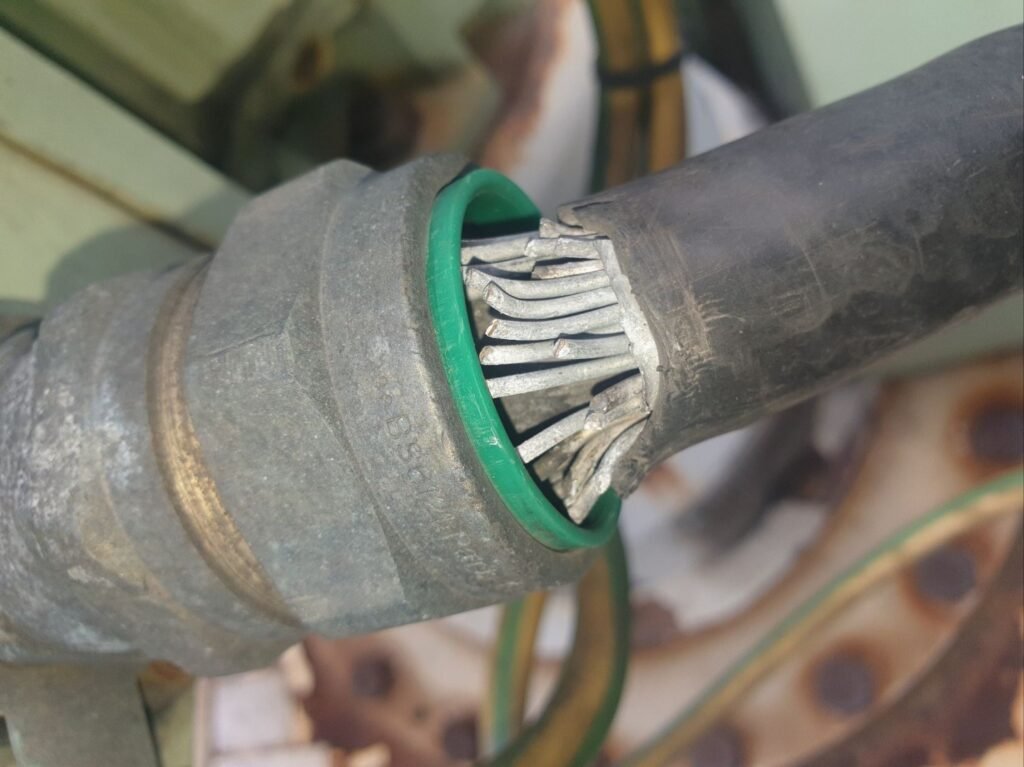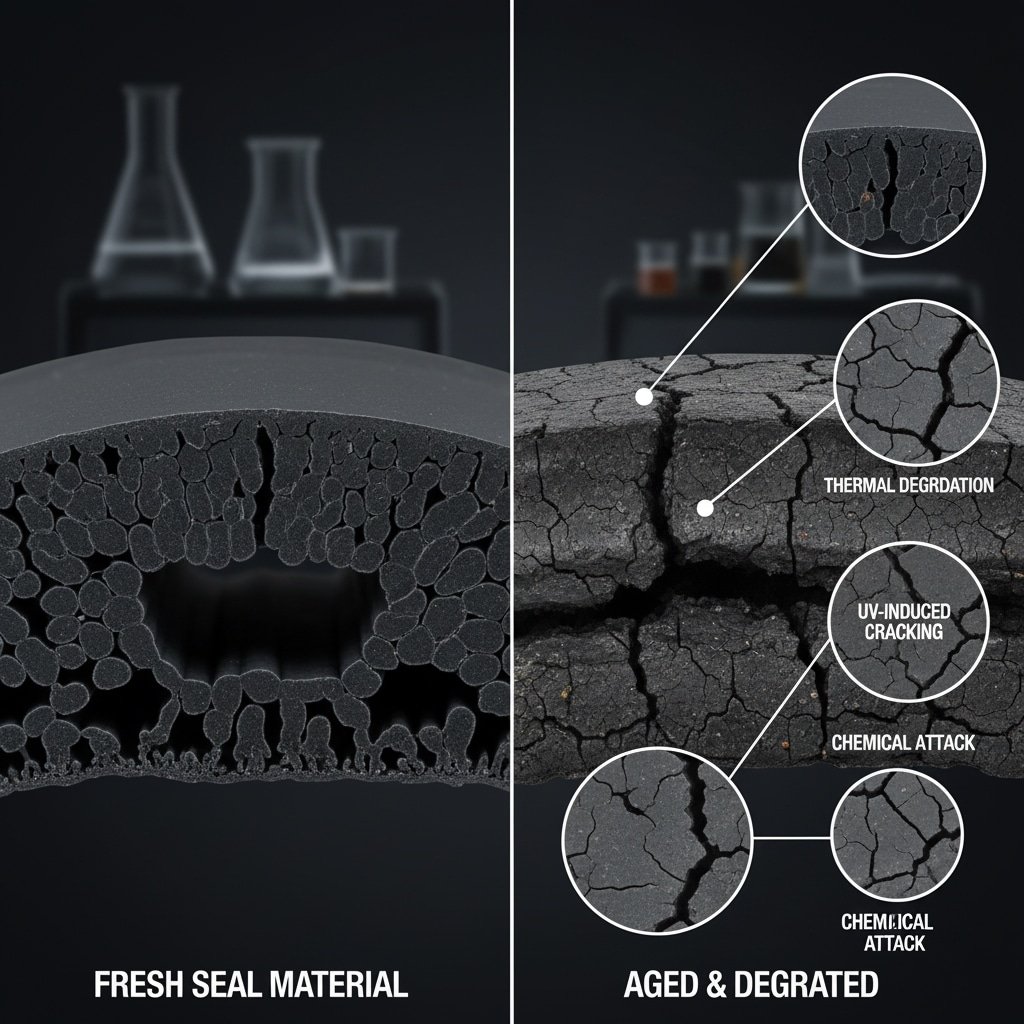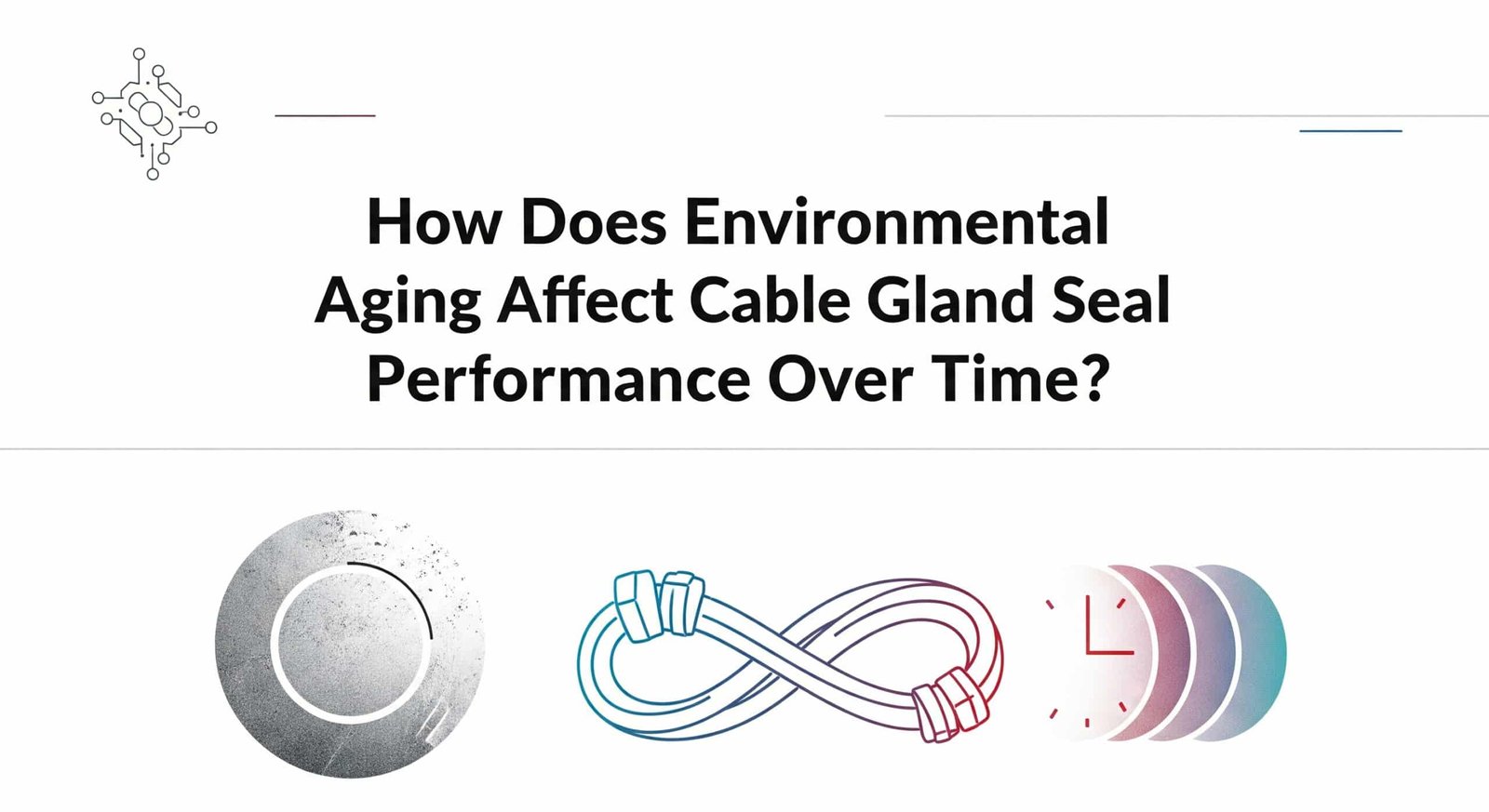
Introduction
Imagine discovering that your critical infrastructure’s cable glands have failed after just two years instead of the expected 20-year lifespan. Environmental aging silently degrades seal performance, turning reliable connections into potential failure points that can cost millions in downtime and safety hazards.
Environmental aging from heat, UV radiation, and chemical exposure significantly reduces cable gland seal performance by 30-70% over time, with elastomer hardening, cracking, and dimensional changes being the primary failure mechanisms that can be mitigated through proper material selection and accelerated aging testing protocols. Understanding these degradation patterns enables engineers to specify appropriate sealing solutions for long-term reliability.
Last year, Marcus, an operations manager at a solar farm in Arizona, contacted me after experiencing widespread seal failures in their cable glands after only 18 months of desert exposure. The combination of extreme heat and UV radiation had turned their standard seals brittle, compromising IP ratings1 and threatening equipment safety. This real-world scenario perfectly illustrates why aging effects on seal performance demand serious attention from engineers and procurement professionals.
Table of Contents
- What Are the Primary Aging Mechanisms Affecting Cable Gland Seals?
- How Does Heat Aging Impact Different Seal Materials?
- What Role Does UV Radiation Play in Seal Degradation?
- How Do Chemical Exposures Affect Long-Term Seal Performance?
- Which Materials Offer Superior Aging Resistance?
- FAQs About Cable Gland Seal Aging
What Are the Primary Aging Mechanisms Affecting Cable Gland Seals?
Understanding the fundamental aging processes helps engineers predict and prevent premature seal failures in demanding applications.
The primary aging mechanisms affecting cable gland seals include thermal degradation causing polymer chain scission2, UV-induced photooxidation leading to surface cracking, chemical attack from oils and solvents causing swelling or hardening, and ozone exposure resulting in stress cracking, with each mechanism following predictable degradation patterns that can be accelerated for testing purposes. These mechanisms often work synergistically, accelerating overall degradation rates beyond individual effects.

Thermal Degradation Mechanisms
Heat exposure initiates several destructive processes in elastomeric seals:
Polymer Chain Scission:
- High temperatures break molecular bonds in elastomer chains
- Results in reduced tensile strength and elongation properties
- Accelerated by oxygen presence (thermo-oxidative degradation)
Cross-linking Changes:
- Additional cross-links form, increasing hardness
- Reduced flexibility and compression set3 resistance
- Loss of elastic recovery properties
Volatile Loss:
- Plasticizers and processing aids evaporate at elevated temperatures
- Material becomes brittle and prone to cracking
- Dimensional shrinkage affects sealing contact pressure
UV Radiation Effects
Ultraviolet exposure creates specific degradation patterns:
Photooxidation Process:
- UV energy breaks polymer bonds, creating free radicals
- Oxygen reacts with free radicals, forming carbonyl groups
- Surface layer becomes brittle while core remains flexible
Surface Cracking:
- Differential degradation between surface and core creates stress
- Micro-cracks propagate under mechanical stress
- Compromised barrier properties allow moisture ingress
Chemical Attack Mechanisms
Various chemicals cause different degradation modes:
Swelling Degradation:
- Compatible solvents cause polymer swelling
- Reduced mechanical properties and dimensional instability
- Potential extrusion from gland housing
Hardening Effects:
- Certain chemicals extract plasticizers or cause additional cross-linking
- Increased hardness and reduced flexibility
- Compression set and sealing force degradation
How Does Heat Aging Impact Different Seal Materials?
Temperature effects vary significantly across different elastomer families, making material selection critical for high-temperature applications.
Heat aging impacts vary dramatically by material type, with silicone maintaining flexibility up to 200°C while standard nitrile hardens significantly above 100°C, EPDM showing excellent thermal stability to 150°C, and fluoroelastomers (Viton) providing superior performance to 250°C, making material selection crucial for temperature-specific applications. Our comparative testing reveals these performance differences through accelerated aging protocols.
Material Performance Comparison
| Material Type | Max Service Temp | Heat Aging Resistance | Typical Applications |
|---|---|---|---|
| Standard NBR | 100°C | Poor | General industrial |
| HNBR | 150°C | Good | Automotive, oil & gas |
| EPDM | 150°C | Excellent | Outdoor, steam |
| Silicone | 200°C | Excellent | High temp, food grade |
| Fluoroelastomer | 250°C | Outstanding | Chemical, aerospace |
Accelerated Aging Test Results
Our laboratory conducts systematic aging studies following ASTM D5734 protocols:
Test Conditions:
- Temperature: 70°C, 100°C, 125°C, 150°C
- Duration: 168, 504, 1008 hours
- Properties measured: Hardness, tensile strength, elongation, compression set
Key Findings:
- NBR shows 40% hardness increase after 1000 hours at 100°C
- EPDM maintains stable properties up to 150°C for extended periods
- Silicone demonstrates minimal property changes across temperature range
- Fluoroelastomers show less than 10% property degradation at 200°C
Real-World Performance Correlation
Laboratory results must correlate with field performance. We track installations in various environments:
High-Temperature Applications:
- Steel mill cable glands operating at 120°C ambient
- Power plant installations with steam exposure
- Desert solar installations with 80°C surface temperatures
Performance Monitoring:
- Annual seal inspection and property testing
- Failure analysis of removed components
- Correlation between lab predictions and field performance
Hassan, who manages a petrochemical facility in Kuwait, initially specified standard NBR seals for cost reasons. After experiencing failures within 6 months due to 60°C ambient temperatures and hydrocarbon exposure, he switched to our HNBR seals. The upgrade eliminated failures and reduced maintenance costs by 75% over two years, demonstrating the value of proper material selection for thermal environments.
What Role Does UV Radiation Play in Seal Degradation?
Ultraviolet exposure creates unique degradation patterns that differ significantly from thermal aging, requiring specific material formulations for outdoor applications.
UV radiation causes photooxidation in elastomer surfaces, creating a brittle outer layer while the core remains flexible, leading to surface cracking that compromises sealing integrity within 2-5 years depending on material formulation and UV intensity, with carbon black loading and UV stabilizers providing significant protection against degradation. Understanding UV effects enables proper specification for outdoor installations.

UV Degradation Mechanisms
Ultraviolet radiation initiates complex chemical reactions:
Photon Energy Absorption:
- UV wavelengths (280-400nm) provide sufficient energy to break polymer bonds
- Shorter wavelengths (UV-B, UV-C) cause more severe damage
- Intensity and exposure duration determine degradation rate
Free Radical Formation:
- Broken bonds create reactive free radical species
- Chain reactions propagate damage throughout polymer structure
- Oxygen presence accelerates oxidation processes
Surface Layer Effects:
- Degradation concentrated in top 50-100 microns
- Creates differential properties between surface and core
- Stress concentration leads to crack initiation and propagation
Material Susceptibility Ranking
Different elastomers show varying UV resistance:
High Susceptibility:
- Natural rubber: Rapid degradation, cracking within months
- Standard NBR: Moderate degradation, surface hardening
- Standard EPDM: Good base resistance, improved with additives
Low Susceptibility:
- Silicone: Excellent UV stability, minimal property changes
- Fluoroelastomers: Outstanding resistance to UV and ozone
- Specialized UV-stabilized compounds: Enhanced protection through additives
Protection Strategies
Several approaches minimize UV degradation:
Carbon Black Loading:
- 30-50 phr carbon black provides excellent UV screening
- Absorbs UV energy, preventing polymer damage
- Must balance UV protection with other properties
UV Stabilizer Additives:
- Hindered amine light stabilizers (HALS)5
- UV absorbers and antioxidants
- Typically 1-3% loading for effective protection
Physical Protection:
- Pigmentation for UV screening
- Protective housings or covers
- Strategic installation to minimize direct exposure
Accelerated UV Testing
We employ multiple test methods to evaluate UV resistance:
QUV Weatherometer Testing:
- Controlled UV-A or UV-B exposure
- Cyclic conditions with moisture and temperature
- Accelerated aging equivalent to years of outdoor exposure
Xenon Arc Testing:
- Full spectrum solar simulation
- More representative of actual sunlight
- Combined with temperature and humidity cycling
How Do Chemical Exposures Affect Long-Term Seal Performance?
Chemical compatibility extends beyond simple resistance tables, involving complex time-dependent interactions that can dramatically alter seal properties and performance.
Chemical exposures affect seal performance through multiple mechanisms including swelling that reduces mechanical properties, extraction of plasticizers causing embrittlement, stress cracking from aggressive solvents, and chemical cross-linking that increases hardness, with effects varying significantly based on concentration, temperature, and exposure duration rather than simple compatibility ratings. Proper chemical resistance evaluation requires long-term immersion testing under realistic conditions.
Chemical Interaction Mechanisms
Understanding how chemicals affect elastomers enables better material selection:
Swelling Mechanisms:
- Compatible chemicals penetrate polymer matrix
- Molecular chains separate, reducing intermolecular forces
- Results in dimensional growth and property degradation
Extraction Effects:
- Aggressive solvents remove plasticizers and processing aids
- Material becomes brittle and prone to cracking
- Dimensional shrinkage affects sealing contact
Stress Cracking:
- Combination of chemical exposure and mechanical stress
- Micro-cracks initiate at stress concentration points
- Propagation accelerated by continued chemical exposure
Industry-Specific Chemical Challenges
Different industries present unique chemical exposure scenarios:
Oil & Gas Applications:
- Crude oil, refined products, drilling fluids
- H2S (sour gas) causing sulfur cross-linking
- Hydraulic fluids and completion chemicals
Chemical Processing:
- Acids, bases, organic solvents
- Oxidizing agents causing rapid degradation
- High-temperature chemical exposure
Food & Pharmaceutical:
- Cleaning chemicals (CIP solutions)
- Sanitizers and disinfectants
- FDA compliance requirements
Long-Term Immersion Testing
Our chemical resistance evaluation goes beyond standard compatibility charts:
Extended Immersion Protocols:
- 30, 90, 180-day exposures at service temperature
- Multiple chemical concentrations tested
- Property measurements throughout exposure period
Property Tracking:
- Hardness, tensile strength, elongation changes
- Volume swell and dimensional stability
- Compression set under chemical exposure
Real-World Correlation:
- Field samples analyzed after service exposure
- Comparison with laboratory predictions
- Continuous database improvement
Which Materials Offer Superior Aging Resistance?
Material selection for aging resistance requires balancing multiple performance criteria while considering cost-effectiveness and application-specific requirements.
Superior aging resistance is achieved through fluoroelastomers (Viton) for extreme chemical and thermal environments, EPDM with proper compounding for outdoor UV exposure, silicone for high-temperature stability, and specialized HNBR formulations for oil resistance combined with thermal stability, with each material optimized for specific aging mechanisms through careful compound design. Our material development focuses on multi-environmental resistance for demanding applications.
Premium Material Options
Our high-performance seal materials address specific aging challenges:
Fluoroelastomer (FKM) Advantages:
- Outstanding chemical resistance across broad spectrum
- Thermal stability to 250°C continuous service
- Minimal property changes under aging conditions
- Ideal for harsh chemical and thermal environments
Advanced EPDM Formulations:
- Excellent ozone and UV resistance
- Superior low-temperature flexibility
- Steam and hot water resistance
- Cost-effective for outdoor applications
High-Performance Silicone:
- Stable properties from -60°C to +200°C
- Excellent UV and ozone resistance
- Food-grade and biocompatible options
- Minimal compression set under thermal cycling
Compound Optimization Strategies
Material performance enhancement through formulation:
Antioxidant Systems:
- Primary antioxidants prevent initial oxidation
- Secondary antioxidants decompose hydroperoxides
- Synergistic combinations provide enhanced protection
UV Stabilization:
- Carbon black for UV screening
- Hindered amine light stabilizers (HALS)
- UV absorber additives for clear compounds
Cross-link System Selection:
- Peroxide curing for thermal stability
- Sulfur systems for cost-effectiveness
- Specialized systems for chemical resistance
Application-Specific Recommendations
| Environment | Primary Aging Factor | Recommended Material | Expected Service Life |
|---|---|---|---|
| Outdoor Industrial | UV + Ozone | EPDM (Carbon Black) | 15-20 years |
| High Temperature | Thermal | Silicone or FKM | 10-15 years |
| Chemical Processing | Chemical Attack | FKM or HNBR | 5-10 years |
| Marine/Offshore | Salt + UV + Thermal | FKM or Marine EPDM | 10-15 years |
| Food Processing | Cleaning Chemicals | FDA Silicone/EPDM | 3-5 years |
Cost-Performance Analysis
Balancing material costs with lifecycle value:
Initial Cost Considerations:
- Standard NBR: Lowest initial cost
- EPDM: Moderate cost with good performance
- Specialty compounds: Higher initial cost, superior performance
Lifecycle Value:
- Reduced replacement frequency
- Lower maintenance costs
- Improved system reliability
- Reduced downtime costs
ROI Calculation:
- Total cost of ownership analysis
- Failure cost impact assessment
- Maintenance schedule optimization
Conclusion
Environmental aging represents one of the most critical yet often overlooked factors in cable gland seal performance. Through our comprehensive testing and real-world experience, we’ve demonstrated that proper material selection and aging resistance evaluation can extend seal life by 3-5 times compared to standard solutions. The key lies in understanding specific aging mechanisms—heat, UV, and chemical exposure—and selecting materials engineered to resist these challenges. At Bepto, our commitment to advanced materials science and rigorous testing ensures our seals deliver reliable performance throughout their intended service life, providing the long-term value and peace of mind your critical applications demand. 😉
FAQs About Cable Gland Seal Aging
Q: How long should cable gland seals last in outdoor applications?
A: Properly selected seals should last 15-20 years in outdoor applications when using UV-stabilized EPDM or silicone materials with adequate carbon black loading. Standard materials may fail within 2-5 years due to UV degradation and ozone cracking.
Q: What temperature can standard cable gland seals handle?
A: Standard NBR seals are limited to 100°C continuous service, while EPDM performs well to 150°C, and silicone or fluoroelastomer seals can handle 200-250°C depending on the specific compound formulation and application requirements.
Q: How do I know if my seals are aging and need replacement?
A: Look for visible cracking, hardening (Shore A increase >15 points), loss of flexibility, compression set >50%, or compromised IP ratings during testing. Regular inspection every 2-3 years helps identify aging before failure occurs.
Q: Can accelerated aging tests predict real-world performance?
A: Yes, when properly conducted following ASTM standards, accelerated aging tests provide reliable predictions of field performance. We correlate lab results with field data to validate our testing protocols and material recommendations.
Q: What’s the most cost-effective way to improve seal aging resistance?
A: Upgrading to EPDM from standard NBR provides significant aging improvement at moderate cost increase. For extreme environments, the higher cost of fluoroelastomers is justified by extended service life and reduced maintenance requirements.
-
Learn how the Ingress Protection (IP) rating system classifies the sealing effectiveness of electrical enclosures. ↩
-
Understand the chemical process where long polymer chains are broken, leading to material degradation. ↩
-
Explore this critical property that measures a material’s ability to return to its original thickness after compression. ↩
-
Access the official documentation for this standard test method for evaluating the deterioration of rubber in an air oven. ↩
-
Discover the chemical mechanism behind HALS, a key additive used to protect polymers from UV degradation. ↩


